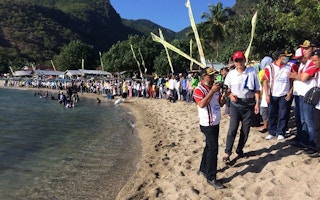“We need to keep this river clean,” says Muhammad Yusuf, a fisheries official from Padang, the capital of the Indonesian province of West Sumatra. “We’ve got to keep people from dumping trash here.”
Nearby, where the river meets the ocean, Padang’s idyllic beaches have become an eyesore, littered with plastic trash.
“We need to make better environmental decisions,” Yusuf says, picking a plastic bag from the water.
Yusuf was one of some 20,000 Indonesians who participated in “Face the Sea,” a one-day event held simultaneously in 76 locations across the country on Aug. 19. The purpose of the event was to draw attention to the alarming spread of plastic waste in the oceans, and the need for better approaches to address the burgeoning crisis.
Indonesia is the world’s second-largest plastic polluter, after China. It produces 3.2 million tonnes of mismanaged plastic waste a year, 1.29 million tonnes of which ends up in the sea.
Some 10 billion plastic bags in the Southeast Asian country alone, weighing 85,000 tons, are dumped into the environment each year, according to state figures.
Globally, ocean currents swirl the trash into giant garbage patches, the biggest of which, in the northern Pacific Ocean, is twice the size of Texas. Not a single square mile of the Earth’s ocean surface is plastic-free, according to the Center for Biological Diversity.
When marine creatures like whales, sea turtles or fish mistake floating plastic waste for food, they swallow material they can’t digest. The plastic stays lodged in their guts for life, often to fatal effect. At least 100,000 sea animals and 1 million seabirds die from eating plastic each year, according to Ocean Crusaders, an NGO.
If the dumping continues at this rate, by 2050 the plastic in the oceans will outweigh the fish, says another report.
The plastic crisis is a growing issue in Indonesia, home to some 260 million people. The nation has pledged to reduce its output of plastic into the oceans 70 per cent by 2025.
“
This action demonstrates the public’s commitment to protecting the oceans.
Susi Pudjiastuti, fisheries minister, Indonesia
In 2016, Indonesia rolled out a program in 23 cities, imposing a 200 rupiah (1 U.S. cent) excise on plastic shopping bags.
The tax generated a 55 per cent reduction in plastic waste over the three months it ran, according to the Indonesia Plastic Bag Diet Movement, an advocacy group. But retailers refused to extend the pilot program after three months, suggesting it hurt their business and citing a weak legal basis.
Meanwhile, the government’s plan to impose a new tax—this time on the producers of plastic bags rather than the retailers who sell them—flopped last month amid opposition from manufacturers.
The lack of a major policy response is partly due to low awareness of the problem, observers say, which is what Face the Sea sought to address.
“This action demonstrates the public’s commitment to protecting the oceans,” Susi Pudjiastuti, the Indonesian fisheries minister, said in the coastal town of Bitung, in North Sulawesi province, where she led one of the simultaneous cleanup events.
In neighbouring Gorontalo province, around 2,000 people turned out for another Face the Sea cleanup. The participants included local officials, fishermen, hotel workers, students from vocational schools, and members of the police and military. Goggles were handed out to children and fish distributed to community members as an enticement to participate.
Tiza Mafira, director of the Indonesia Plastic Bag Diet Movement, joined the cleanup in Ancol Beach, along North Jakarta’s heavily polluted coast. She said the trash collected would be sorted and managed by garbage banks and other parties.
Prevention is better than management, Tiza said. She encouraged Indonesians to choose reusable items over disposable plastics.
“The volume of waste collected in each place varies,” she said. She added she hoped to use the event as an opportunity to identify new sources of plastic leaking out into the sea.
At Mertasari Beach in Sanur, a popular tourist destination in Bali, 832 people collected 1.2 tons of beach trash in two hours.
As part of the cleanup, WWF and a student group from nearby Udayana University helped 30 young people learn a waste-cataloguing system developed by the Commonwealth Scientific and Industrial Research Organisation, an Australian government agency. This information will become part of the Indonesian environment ministry’s marine waste database.
Engaging young people is key to the government’s waste reduction strategy, said Permana Yudiarso, a fisheries official in Bali, where the Face the Sea day included a performance by Titi DJ, an Indonesian pop singer, and the supervised release of 150 turtle hatchlings into the sea.
“With [a strong] community of young people, our work is more effective,” he said.
Back in Padang, some 2,500 kilometres (1,550 miles) away, Muhammad Yusuf, the local official, expressed a similar view that more engagement was a missing ingredient in the fight against plastic pollution.
“We need to involve more of the public in cleanup efforts,” he said.
This story was reported by Mongabay’s Indonesia team and was first published on our Indonesian site on Aug. 20, 2018. Republished with permission from Mongabay.com










